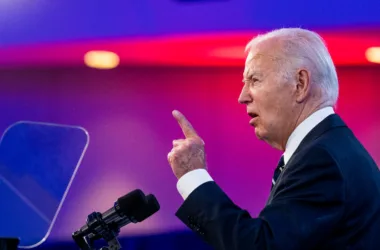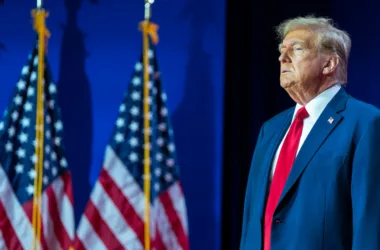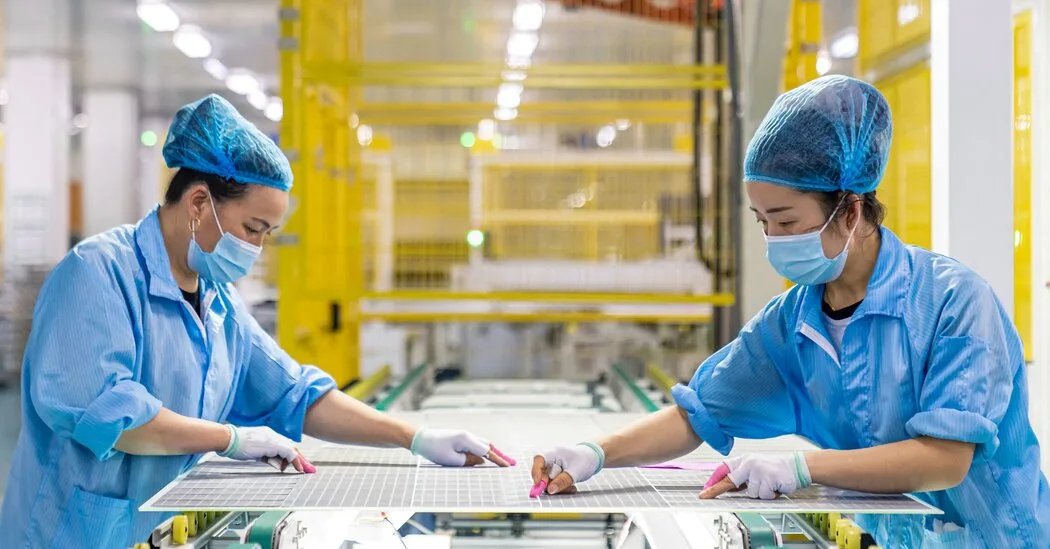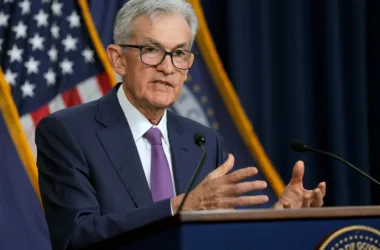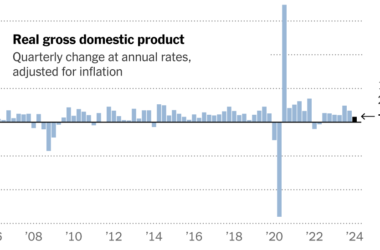Tariffs geared toward defending America’s photo voltaic trade from international competitors snapped again into place on Thursday, ending a two-year pause that President Biden accredited as a part of his effort to jump-start photo voltaic adoption within the U.S.
The tariffs, which can apply to sure photo voltaic merchandise made by Chinese language firms in Southeast Asia, kicked in at a second of rising international concern a few surge of low cost Chinese language photo voltaic merchandise which might be undercutting U.S. and European producers.
The Biden administration has been making an attempt to construct up America’s photo voltaic trade by providing tax credit, and firms have introduced more than 30 new U.S. manufacturing investments up to now yr. However U.S. photo voltaic firms say they’re nonetheless struggling to outlive as rivals in China and Southeast Asia flood the worldwide market with photo voltaic panels which might be being bought at costs far under what American corporations must cost to remain in enterprise.
That has compelled President Biden to make an uncomfortable selection: Proceed welcoming cheap imports which might be serving to america transition away from fossil fuels, or block them to guard new U.S. photo voltaic factories which might be benefiting from taxpayer cash.
The tariffs that take impact Thursday encapsulated that dilemma. The levies, which apply to sure photo voltaic merchandise coming to america from Cambodia, Thailand, Malaysia and Vietnam, had been accredited two years in the past, after U.S. officers dominated that some Chinese language corporations had been making an attempt to dodge preexisting American tariffs on China by routing photo voltaic panels via different nations. The precise tariff fee will depend on the corporate however may very well be greater than 250 %.
The Chinese language corporations had arrange factories in Southeast Asia, however Commerce Division officers stated that some weren’t doing substantial manufacturing there. Relatively, they had been utilizing websites in these nations to make minor adjustments to Chinese language-made photo voltaic merchandise, after which transport them to america tariff-free, the ruling determined.
These merchandise ought to have been topic to extra tariffs, however the Biden administration made an uncommon determination in June 2022 to quickly pause them for 2 years, to make sure that america would nonetheless have entry to loads of photo voltaic panels. Congress handed a decision final yr to reinstate the tariffs, however Mr. Biden vetoed it.
The administration described the choice to droop the tariffs as a compromise. Teams just like the American Clear Energy Affiliation, which represents utility photo voltaic and power storage firms, had argued that imposing the tariffs would hurt U.S. efforts to fight local weather change. However the determination angered most of the home photo voltaic producers that the Biden administration additionally wished to assist.
Within the two years because the Biden administration made the choice to pause the tariffs, photo voltaic costs have cratered, and photo voltaic panel imports have surged.
Danny O’Brien, the president of company affairs for Qcells, which makes photo voltaic panels in Georgia, stated there have been almost two yr’s value of sponsored, imported photo voltaic panels sitting in U.S. warehouses. “We welcome President Biden’s vital steps to stage the taking part in area,” he stated. “But when we wish to construct a sturdy home provide chain that meets our local weather targets, continues to create jobs and provides to our power safety, the Biden administration’s industrial insurance policies might want to evolve additional and be forceful.”
Over the past yr, Biden administration officers have grown more and more vocal concerning the threat that imports pose, and the necessity to shield nascent factories, a few of them in key electoral states.
In March, Treasury Secretary Janet L. Yellen delivered a speech in Norcross, Ga., at Suniva, a struggling photo voltaic producer that has obtained subsidies via the 2022 Inflation Discount Act. Ms. Yellen famous that the corporate, which filed for chapter in 2017, is now restarting manufacturing of photo voltaic cells this yr.
Nevertheless, she additionally instructed that such investments may very well be threatened by China’s extra industrial capability of inexperienced power know-how. “China’s overcapacity distorts international costs and manufacturing patterns and hurts American corporations and employees, in addition to corporations and employees world wide,” she stated.
The Treasury secretary raised the case of Suniva once more in April at a information convention in Beijing, the place she was assembly with senior Chinese language officers. She recalled that Suniva’s monetary troubles began greater than a decade in the past when China began ramping up its manufacturing of low cost photo voltaic panels.
Whereas the agency now had extra assist from the U.S. authorities, she stated, “the continued funding in capability in these areas in China, that outstrips rising international demand, actually may start to threaten an organization like this.”
It’s not but clear how most of the Chinese language firms routing merchandise via Southeast Asia will nonetheless face tariffs, if any. Within the final two years, many have constructed up factories in Southeast Asia which will permit them to argue that they’re doing substantial manufacturing there, not merely circumventing tariffs by routing items via these nations, trade executives stated.
Within the meantime, U.S. photo voltaic makers have begun urgent for broader protections. In April, a gaggle of American photo voltaic producers filed one other set of instances with the Commerce Division and the U.S. Worldwide Commerce Fee, asking them to research unfair subsidies and pricing practices from factories in Cambodia, Malaysia, Thailand and Vietnam.
The fee is ready to make an preliminary dedication Friday about whether or not U.S. enterprise have suffered damage from these practices. If it decides that they’ve, extra levies may very well be imposed on imports from Southeast Asia, the supply of a majority of U.S. photo voltaic panels.
“We don’t anticipate that the lifting of the tariff vacation can have a lot of an affect as a result of the Chinese language-owned and Chinese language-headquartered firms have already adjusted their manufacturing to keep away from the circumvention case,” stated Timothy Brightbill, a lawyer at Wiley Rein who’s representing the U.S.-based photo voltaic producers within the newer case. “Our case is extraordinarily necessary as a result of it form of picks up the place the circumvention case left off.”
The back-and-forth over the tariffs highlights a dilemma america faces because it tries sever some hyperlinks to China. Chopping ties has been notably tough in inexperienced industries the place China dominates international manufacturing, like photo voltaic panels, important minerals and electrical automobile batteries.
China accounts for greater than 80 percent of world photo voltaic provide at each stage of the manufacturing chain, from the uncooked materials of polysilicon to the ultimate panels.
Substantial assist from the Chinese language authorities — in addition to the huge economies of scale that the Chinese language trade has achieved — has allowed Chinese language makers to supply their merchandise at extraordinarily low costs. Based on information from Wooden Mackenzie, photo voltaic modules value simply 9 to 11 cents per watt in China, in contrast with 27 to 33 cents a watt for these made in america. Many U.S. factories are at the moment promoting modules both at value or for unfavorable revenue margins with a purpose to compete with imports, Wooden Mackenzie stated.
These low costs triggered a surge in imports. Based on information from S&P World, america imported a report 54 gigawatts of photo voltaic panels in 2023, up 82 % from 2022.
Some argue that america ought to merely benefit from these low cost costs to construct out its solar energy provide. However the glut can also be placing Mr. Biden’s plans to revive inexperienced power manufacturing in america in danger. Some new producers have been discouraged from opening amenities in america. In February, a Massachusetts firm referred to as CubicPV Inc. canceled plans to construct a manufacturing facility for photo voltaic wafers, citing collapsing costs.
Underneath the principles, firms should technically set up all the photo voltaic panels that they introduced into america tariff-free earlier than December, or find yourself paying tariffs retroactively,
“The scramble is on now for firms to make use of up their inventory over the following six months,” stated Mona Dajani, international co-chair of power infrastructure and hydrogen at Baker Botts. “Many within the trade are positive to be holding their eyes on how this impacts set up and pricing numbers within the coming weeks.”

